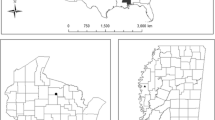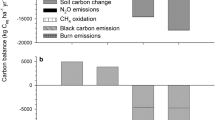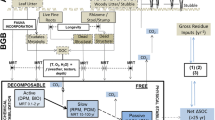Abstract
To estimate fossil fuel demand and greenhouse gas emissions associated with short-rotation willow (Salix spp.) crops in New York State, we constructed a life cycle assessment model capable of estimating point values and measures of variability for a number of key processes across eight management scenarios. The system used 445.0 to 1,052.4 MJ of fossil energy per oven-dry tonne (odt) of delivered willow biomass, resulting in a net energy balance of 18.3:1 to 43.4:1. The largest fraction of the energy demand across all scenarios was driven by the use of diesel fuels. The largest proportion of diesel fuel was associated with harvesting and delivery of willow chips seven times on 3-year rotations over the life of the crop. Similar patterns were found for greenhouse gas emissions across all scenarios, as fossil fuel use served as the biggest source of emissions in the system. Carbon sequestration in the belowground portion of the willow system provided a large carbon sink that more than compensated for carbon emissions across all scenarios, resulting in final greenhouse gas balances of −138.4 to −52.9 kg CO2 eq. per odt biomass. The subsequent uncertainty analyses revealed that variability associated with data on willow yield, litterfall, and belowground biomass eliminated some of the differences between the tested scenarios. Even with the inclusion of uncertainty analysis, the willow system was still a carbon sequestration system after a single crop cycle (seven 3-year rotations) in all eight scenarios. A better understanding and quantification of factors that drive the variability in the biological portions of the system is necessary to produce more precise estimates of the emissions and energy performance of short-rotation woody crops.



Similar content being viewed by others
References
Volk TA, Verwijst T, Tharakan PJ, Abrahamson LP (2004) Growing energy: assessing the sustainability of willow short-rotation woody crops. Front Ecol Environ 2:411–418
Rowe RL, Street NR, Taylor G (2009) Identifying environmental impacts of large-scale deployment of dedicated bioenergy crops in the UK. Renew Sustain Energy Rev 13:271–290
Volk TA et al (2011) Chapter 7. Woody feedstocks—management and regional differences. In: Braun R, Karlen D, Johnson D (eds) Sustainable feedstocks for advanced biofuels: sustainable alternative fuel feedstock opportunities, challenges, and roadmaps for six U.S. regions. Proceedings of the Sustainable Feedstocks for Advance Biofuels Workshop, 28–30 September 2010. Soil and Water Conservation Society, Atlanta, pp 99–120
U.S. Department of Energy (2011) U.S. billion-ton update: supply for a bioenergy and bioproducts industry. Perlack RD, Stokes BJ (Leads), ORNL/TM-2011/224. Oak Ridge National Laboratory, Oak Ridge
Fantozzi F, Buratti C (2010) Life cycle assessment of biomass chains: wood pellet from short rotation coppice using data measured on a real plant. Biomass Bioenergy 34:1796–1804
Buonocore E, Franzese PP, Ulgiati S (2011) Assessing the environmental performance and sustainability of bioenergy production in Sweden: a life cycle assessment perspective. Energy. doi:10.1016/j.energy.2011.07.032
Djomo SN, El Kasmioui O, Ceulemans R (2011) Energy and greenhouse gas balance of bioenergy production from poplar and willow: a review. Glob Chang Biol Bioenergy 3:181–197
Neupane B, Halog A, Dhungel S (2011) Attributional life cycle assessment of woodchips for bioethanol production. J Clean Prod 19:733–741
Heller MC, Keoleian GA, Volk TA (2003) Life cycle assessment of a willow bioenergy cropping system. Biomass Bioenergy 25:147–165
Pré Consultants (2012) SimaPro 7 life-cycle assessment software package, version 7.3.2. Amersfoot, the Netherlands. http://www.pre-sustainability.com Accessed 5 Sept 2012
Puettmann M (2009) CORRIM LCI database project guidelines for LCI data developers. Woodlife Environmental Consultants.
International Organization for Standardization (2006) Environmental management. Life cycle assessment. Principles and framework. ISO 14040:2006. ISO, Geneva
International Organization for Standardization (2006) Environmental management. Life cycle assessment. Requirements and guidelines. ISO 14044:2006. ISO, Geneva
Abrahamson LP, Volk TA, Smart LB, Cameron K (2010) Shrub willow biomass producers’ handbook. SUNY ESF, Syracuse
Johnson DR, Willis HH, Curtright AE, Samaras C, Skone T (2011) Incorporating uncertainty analysis into life cycle estimates of greenhouse gas emissions from biomass production. Biomass Bioenergy 35:2619–2626
Sanchez ST, Woods J, Akhurst M, Brander M, O’Hare M, Dawson TP, Edwards R, Liska AJ, Malpas R (2012) Accounting for indirect land-use change in the life cycle assessment of biofuel supply chains. J R Soc Interface 9:1105–1119
Budsberg E, Rastogi M, Puettmann ME, Caputo J, Balogh S, Volk TA, Gustafson R, Johnson L (2012) Life-cycle assessment for the production of bioethanol from willow biomass crops via biochemical conversion. For Prod J 62:305–313
National Renewable Energy Laboratory (2012) U.S. life-cycle inventory database. https://www.lcacommons.gov/nrel/. Accessed 30 Sept 2012.
EcoInvent Centre (2013) Ecoinvent database version 2.2. http://www.ecoinvent.ch. Accessed 22 March 2013
Bucholz T, Volk TA (2011) Identifying opportunities to improve the profitability of willow biomass crops with a crop budget model. Bioenergy Res 4:85–95
Volk TA, Abrahamson LP, Cameron KP, Castellano P, Corbin T, Fabio E, Johnson G, Kuzovkina-Eischen Y, Labrecque M, Miller R, Sidders D, Smart LB, Staver K, Stanosz GR, Van Rees K (2011) Yields of willow biomass crops across a range of sites in North America. In: Booth E, Halford N, Sheild I, Taylor G, Turley D, Voight T (eds) Aspects of applied biology, 112; biomass and energy crops IV, 21–23 September 2011. The Association of Applied Biologists, Champaign, pp 67–74
Wojnar, Z. (Lead.) (2010) Appendix F: feedstock transportation and logistics. In: Jarnefeld J (ed) Renewable fuels roadmap and sustainable biomass feedstock supply for New York. New York State Energy Research and Development Authority (NYSERDA), New York
Adegbidi HG (1994) Nutrient return via litterfall and removal during harvest in a one-year rotation bioenergy plantation. M.S. Thesis. State University of New York College of Environmental Science and Forestry
Pacaldo RS, Volk TA, Briggs RD (2013) Greenhouse gas potentials of shrub willow biomass crops based on below- and aboveground biomass inventory along a 19-year Chronosequence. Bioenergy Res 6:252–262
Pacaldo RS, Volk TA, Briggs RD (2011) Carbon balance in short rotation willow (Salix dasyclados) biomass crop across a 20-year chronosequence as affected by continuous production and tear-out treatments. In: Booth E, Halford N, Shield I, Taylor G, Turley D, Voigt T (eds) Aspects of applied biology, 112; biomass and energy crops IV, 21–23 September 2011. The Association of Applied Biologists, Champaign, pp 131–138
Quaye A, Volk TA, Hafner S, Leopold D, Schirmer C (2011) Impacts of paper sludge and manure on soil and biomass production of willow. Biomass Bioenergy 35:2796–2806
Quaye A, Volk TA (2011) Soil nutrient dynamics and biomass production in an organic and inorganic fertilized short rotation willow coppice system. Asp Appl Biol 112:121–129
Miles TR, Baxter LL, Bryers RW, Oden LL (1996) Alkali deposits found in biomass power plants: a preliminary investigation of their extent and nature. National Renewable Energy Laboratory. NREL/TP-433-8142.
Searchinger T, Heimlich R, Houghton RA, Dong F, Elobeid A, Fabiosa J, Tokgoz S, Hayes D, Yu T (2008) Use of U.S. croplands for biofuels increases greenhouse gases through emissions from land-use change. Science 319:1238–1240
Wang MQ, Han J, Haq Z, Tyner WE, Wu M, Elgowainy A (2011) Energy and greenhouse gas emission effects of corn and cellulosic ethanol with technology improvements and land use changes. Biomass Bioenergy 35:1885–1896
Ulzen-Appiah F (2002) Soil organic matter in experimental short rotation intensive culture (SRIC) systems: effects of cultural factors, season, and age. Ph.D. dissertation, State University of New York College of Environmental Science and Forestry
Nikièma P, Rothstein DE, Miller RO (2012) Initial greenhouse gas emissions and nitrogen leaching losses associated with converting pastureland to short-rotation woody bioenergy crops in northern Michigan, USA. Biomass Bioenergy 39:413–426
Arevalo CBM, Bhatti JS, Chang SX, Sidders D (2011) Land use change effects on ecosystem carbon balance: from agricultural to hybrid poplar plantation. Agric Ecosyst Environ 141:342–349
Puettmann M, Lippke B (2012) Woody biomass substitution for thermal energy at softwood lumber mills in the US Inland Northwest. Forest Prod J 62:273–279
Caputo J, Volk TA, Abrahamson LP, Johnson G (2010) Effects of planting density on growth, mortality and yield of short rotation willow crops. Presentation at: 8th Biennial Short Rotation Woody Crops Operations Working Group—Short rotation woody crops in a renewable energy future: challenges and opportunities, Syracuse
Acknowledgements
Support for this project was provided by the U.S. Department of Energy Bioenergy Technology Office. Data used to develop the model were collected and analyzed with support from the New York State Energy Research and Development Authority (NYSERDA), United States Department of Agriculture's Agriculture and Food Research Initiative (USDA AFRI) program.
Author information
Authors and Affiliations
Corresponding author
Rights and permissions
About this article
Cite this article
Caputo, J., Balogh, S.B., Volk, T.A. et al. Incorporating Uncertainty into a Life Cycle Assessment (LCA) Model of Short-Rotation Willow Biomass (Salix spp.) Crops. Bioenerg. Res. 7, 48–59 (2014). https://doi.org/10.1007/s12155-013-9347-y
Published:
Issue Date:
DOI: https://doi.org/10.1007/s12155-013-9347-y




